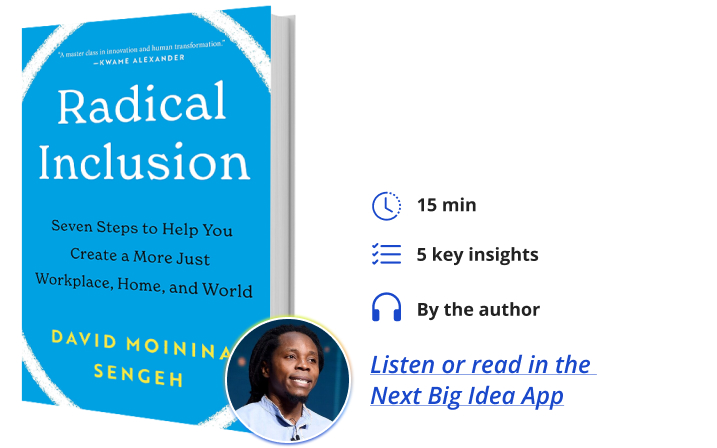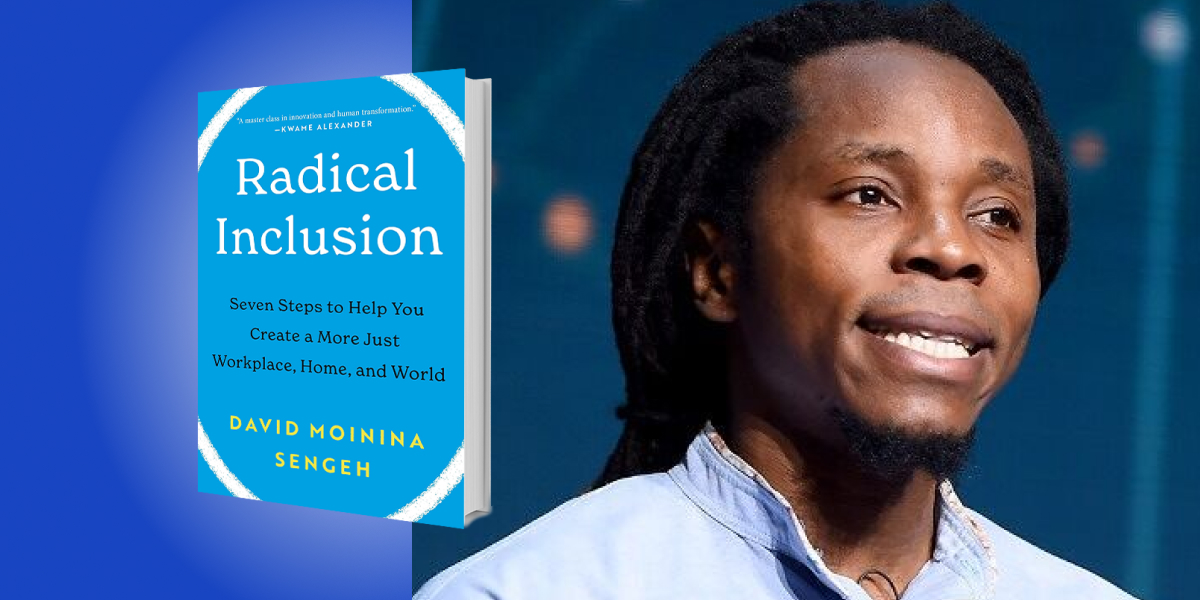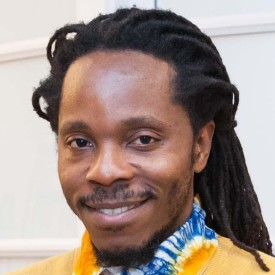David Moinina Sengeh is Minister of Basic and Senior Secondary Education in Sierra Leone. He is a TED Senior Fellow and holds a Ph.D. in biomedical engineering from MIT. He previously designed and developed healthcare technologies in Africa for IBM Africa.
Below, David shares five key insights from his new book, Radical Inclusion: Seven Steps to Help You Create a More Just Workplace, Home, and World. Listen to the audio version—read by David himself—in the Next Big Idea App.

1. You are not included.
Fighting for inclusion first requires identifying the exclusion, naming it, defining it, learning about it, and then listening. This also involves listening to people, including those you don’t agree with, and defining your role. Why you? Why not you? Why now? Building a coalition, taking action, and then after you’ve succeeded in taking action, adapting to that new normal.
Often we think inclusion or exclusion is about other people. We tend to think that exclusion does not apply to us because we are of a certain class or a certain race or group, but at some point we will face exclusion.
Some will experience it more than others, of course. If you are a woman, for example, you have experienced systematic exclusion in the workplace, at home, and in the community. If you are poor, if you have a disability, you know that most of our built environments and our institutions are really not for you. They’re not built for inclusion. If you are a person of color or of a minority group, you certainly are not included.
2. You might be part of the exclusion.
You might be part of the exclusion, but it’s important that we are able to understand that this does not make you a bad person. If you’re a boss who’s trying to have some engagement with your staff, do you invite them to the floor that they usually don’t come to? Who’s in the room, who’s not in the room? Who is at the table? Who is talking and who is not talking? Are they saying what they truly feel like saying?
“It’s important that we question ourselves.”
We need to be aware of how we might be supporting a system that maintains the status quo and is not inclusive of everyone, whether it’s women, disabled people, or the poor. It’s important that we question ourselves. What games are we playing? What parties are we hosting? Who’s at the party? How are we interacting with the interns? How are we interacting with the new kid who just showed up? Do we have activities that include people with crutches? Do we have activities that address people who have a hearing impairment? Do we have people who cannot afford to join us on trips that have a cost?
It’s important that we pause to understand and reflect on how, and in what ways, we may be actively, unintentionally, or systematically part of a process where we are keeping others out.
3. It is in the interest of everyone to work on inclusion.
It is in everyone’s interest to work on inclusion. Take for example the ramps in buildings. Those ramps are for people with wheelchairs and for disability access, and yet, the people who use them the most are mothers or fathers who are using baby strollers, business people using suitcases, and postal workers coming to drop in your packages. They use the ramps even more than people with disabilities and in wheelchairs.
Think about eyeglasses. There are 2.3 billion people who use these glasses. They are a 700-year-old innovation and have transformed how all of us can participate, even as we lose our eyesight with age. Paid family leave and social welfare, for example, also benefit us all by improving the system as a whole.
4. A more just world is possible.
It might seem like it’s really difficult for us to work on inclusion. The topics are hard, they can divide families, and often people don’t know how to engage. When we debate, we get entrenched in our views.
“I regained hope because he was open to listening to new ideas.”
On the day that I became education minister, my president, President Julius Maada Bio, announced that he would uphold the ban to prevent pregnant girls from going to school. I went from being super excited that morning to very sad and depressed. I reflected on how I would be the one who has to tell my daughters and other people that I am working on the policy to keep girls from going to school. This policy would include girls who often are victims, and become pregnant against their wishes. But, since I was able to work with the president, I regained hope because he was open to listening to new ideas. We got the data, we listened to people, and we built a case that allowed the government of Sierra Leone to overturn the ban.
Then we went one step further. We passed a law that now makes it a right, not just for pregnant girls, but for people with disabilities—both seen and unseen—to have access to education. Inclusion is possible and we can work toward it more quickly when we build the right coalition, and when we have the support to fight for inclusion.
5. The work does not end.
When we win—for example, when more women have paid leave in our organization—we don’t stop there. When more women are participating in political space and we’ve increased that number by a certain percentage, we don’t stop there.
If we let up, we move backward, as we have seen recently with the reproductive rights of women in the United States with the overturning of Roe V. Wade. We’ve seen that access to education is being challenged. Things that we have taken for granted, we see being questioned again.
“There’s business value and financial value to working for the high hanging fruits.”
We have to understand that the work does not end when we achieve one thing. We have to keep going, otherwise, it’s two steps forward, one step back. Even if we have to take one step forward every time, that’s what’s important. It’s important that we do not retrogress and that we can keep working on things that will keep expanding the inclusion circle wherever that border is until we can get ever closer to a more just society.
It’s common for people to talk about the low-hanging fruit which generally refers to things in a really short term. It’s a shortsighted perspective, and it’s about getting returns quickly and moving on to something else.
However, when we work for the high hanging fruit, we actually get more. There’s business value and financial value to working for the high hanging fruits, and to make sure that we do the difficult thing. We solve the difficult problem, we build the systems, and by doing so, we build the tall ladder. We take time, we are patient to make sure that everybody is included, to make sure that we are able to deliver on the goals of radical inclusion.
To listen to the audio version read by author David Moinina Sengeh, download the Next Big Idea App today:































